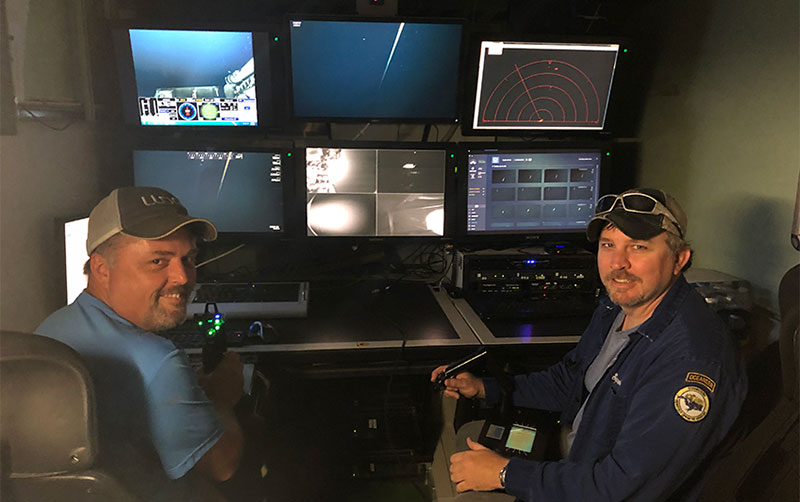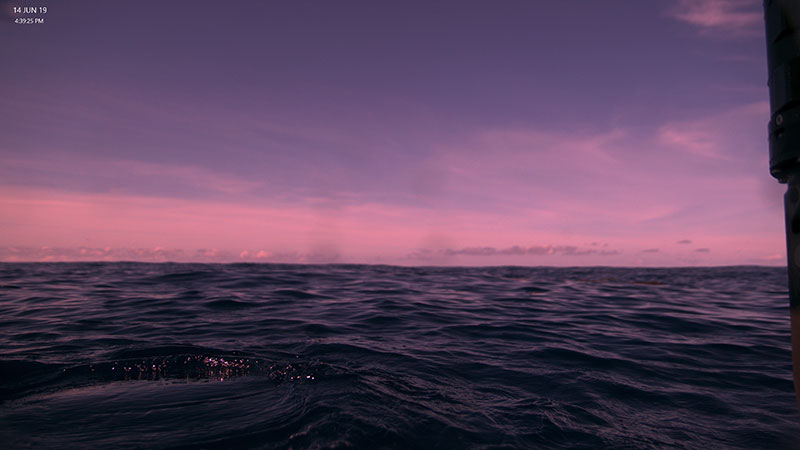
By Travis Kolbe, ROV Superintendent - Oceaneering International
June 19, 2019

Oceaneering ROV pilots Travis Kolbe (left) and Jason Tripp (right). Image courtesy of Journey into Midnight: Light and Life Below the Twilight Zone. Download larger version (jpg, 4.5 MB).
Up until a week ago or so I didn’t know what a BLOG was until I started working with some scientist that “schooled” me on what it means. So here is my first ever.....BLOG.
I’m a remotely operated vehicle (ROV) pilot/technician on this cruise. My routine starts off with a nice 05:20 am wakeup call with my phone, but I don’t use the snooze button. I get suited up with my “office clothes” – fire retardant apparel that when worn is supposed to help prevent burns from flames, but doesn’t do so well with becoming dehydrated (but you can’t pick and choose). The next item on the list is to grab my coffee mug, which is so large it has been referred to as a mini-keg, but I don’t complain. I work my way up the ladder from the lower deck of the vessel to the mess deck, where I’m spotting how much coffee is in the coffee pot and deciding if I need to start a fresh pot now or wait.

View at the ocean surface from the Global Explorer ROV during its recovery to R/V Point Sur at the end of a dive. The color in the image is altered from the filters set for deep water. Image courtesy of NOAA OER/Global Explorer. Download larger version (jpg, 5.2 MB).
After an hour or so of waking up; drinking coffee; and going over various emails, texts, and news headlines, it is time to go out and start the inspection of the ROV. I’m looking over all the electrical connections to make sure they are secure and tight and all the hydraulic fittings to make sure no oil has found a crack in a fitting or hose. Since both items are the lifeblood of the ROV, ensuring they are 100 percent tight and fastened is critical.
The pre-dive check to an ROV is also critical. Does the 4k camera that we use still zoom and focus properly? Does the lens need cleaning? Is the sonar on the top right monitor working properly and giving you the correct feedback? What about the 3D camera system? When was the last time anyone used it? The ROV depth indicator is also zeroed out on deck, which helps keep an accurate depth measurement.
Now it’s time to get the ROV in the water. As I watch from the monitor in front of me, the deck officer instructs me when the hook that has just lifted the ROV off the deck and placed the ROV in the water has been released from the ROV. NOW IT’S TIME TO DIVE.....
“TURN LEFT 20 DEGREES, START GOING FORWARD” says the deck officer... I repeat the command, it’s essential to repeat the command, as this way you can verify what the deck officer is having you do; otherwise, you could drive right into the vessel and the propeller of the vessel and that would kill the job.
Once the “tether” that connects the ROV to the vessel has been cleared over the side, it’s time to dive the ROV down into the dark depths to see the fish... BUT WAIT, we have extremely bright lights and even at 1,000 meters (3,280 feet), the darkness opens up and all the SEA SNOW is clearly visible as we descend even further down looking for BIOLOGICS for the scientist who is sitting at my side, trying to get the focus of the 4K right so it doesn’t look like you need those reading glasses. And down below, in the mess deck you know someone is yelling “FOCUS THE CAMERA.’ But I have a smile on my face because I get to do the driving and see the life in the great deep beneath the ship. 😀

Coryphaenoides alateralis (a.k.a., rattail fish). Image courtesy of NOAA OER/Global Explorer. Download larger version (jpg, 4.9 MB).